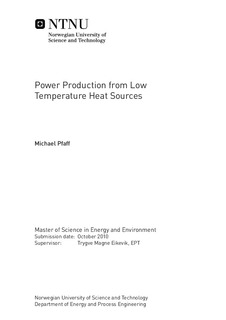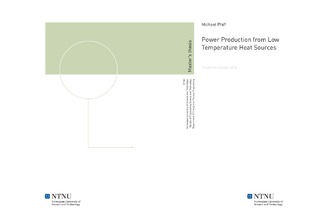| dc.contributor.advisor | Eikevik, Trygve Magne | nb_NO |
| dc.contributor.author | Pfaff, Michael | nb_NO |
| dc.date.accessioned | 2014-12-19T11:48:37Z | |
| dc.date.available | 2014-12-19T11:48:37Z | |
| dc.date.created | 2012-11-08 | nb_NO |
| dc.date.issued | 2010 | nb_NO |
| dc.identifier | 565825 | nb_NO |
| dc.identifier | ntnudaim:5855 | nb_NO |
| dc.identifier.uri | http://hdl.handle.net/11250/234702 | |
| dc.description.abstract | SummaryThis Master Thesis is a conclusion on work done as part of the Resource Optimizationand recovery in the Materials industry project (Roma). This project is involved in thedevelopment of a new technology for power production from low temperature heat sourcesfor off gases from aluminum production cells. The technology is based on an transcriticalRankine cycle with CO2 as a working fluid, as the work recovery circuit. The center ofthe test facility is the expander, a prototype provided by Obrist Engineering . 81 testswere perfomed to investigate the behavoir of the expander cycle. Effect of three mainparameters were investigated:• Effect CO2 massflow rate• Effect of heat source temperature• Effect of CO2 condensation pressureFor each parameter combination, the high pressure side of the expander cycle was variedin order to find the maximum power output.This study clearly showed limitation of the turbine which cannot maintain large pressuredifference probably due to large internal leakages. As a result, turbine outlet is highlysuperheated. This superheat is lost energy for the power cycle, and is simply dumpedinto the heat sink. One possible improvement would be to include a recuperator thatrecovers superheat after the pump.The results also indicate that the fan of the air loop is too small: increasing the CO2 flowrate to limit superheat at turbine outlet leads to turbine inlet temperature reduction.Last, for large CO2 mass flow rate (3.5 kgmin) which is required for proper operation ofthe turbine, the power generated is too large for the generator installed on the loop. Itstemperature reached 120 °C for some conditions. A new solution should be seeked.Based on experimental results, a mode of the power cycle was implemented in Pro/IIand simulations were run in order to find an improved design. The main goal is to beable to run the cycle at high CO2 mass flow rate: 3.5 kgmin. It was found that the airloop fan should be able to deliver up to 1 260 m3h . The new generator or braking systemshould be able to absorb up to 297 W. | nb_NO |
| dc.language | eng | nb_NO |
| dc.publisher | Institutt for energi- og prosessteknikk | nb_NO |
| dc.subject | ntnudaim:5855 | no_NO |
| dc.subject | MTENERG energi og miljø | no_NO |
| dc.subject | Varme- og energiprosesser | no_NO |
| dc.title | Power Production from Low Temperature Heat Sources | nb_NO |
| dc.type | Master thesis | nb_NO |
| dc.source.pagenumber | 118 | nb_NO |
| dc.contributor.department | Norges teknisk-naturvitenskapelige universitet, Fakultet for ingeniørvitenskap og teknologi, Institutt for energi- og prosessteknikk | nb_NO |

